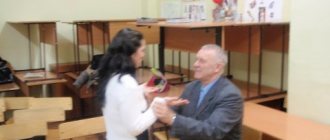| There is a more complete Reinforcement article in another language section. You can help the project by expanding the current article with translation. |
| This is a draft article on psychology. You can help the project by adding to it. |
Reinforcement
- in a broad sense, any event, stimulus, action, reaction or information that, if subsequent to a reaction, serves to increase the relative frequency or probability of occurrence of that reaction[1]. The concept of reinforcement is used differently in different approaches to the study of behavior. In classical conditioning, it is an association formed by repeatedly pairing a conditioned stimulus with an unconditioned stimulus; in operant conditioning, an association formed when an operant response is followed by a reinforcing stimulus[2].
Types of reinforcement
By the nature of reinforcing stimuli
highlight:
- primary
reinforcers, or direct physical rewards, and
secondary
reinforcers, that is, neutral stimuli that are associated with primary reinforcers and thus act as rewards themselves[3]. - positive reinforcement
is carried out with the help of stimuli, the effect of which the subject wants to strengthen or prolong by his behavior;
negative reinforcement
- with the help of stimuli, the effect of which the subject wants to weaken or stop (for example, finish homework sooner) by changing behavior.
Negative reinforcement is not punishment
, since punishment is carried out
after
a behavioral act and does not provide the opportunity to change behavior at the current moment [4].
Positive reinforcement as an effective way of learning and pedagogical communication. article
GBU DO DDT "Yunost"
Positive reinforcement as an effective way of learning and pedagogical communication.
Additional education teacher: Myachina A. A.
Circus group "Courage"
2020
Introduction.
One of the main forms in which the thousand-year wisdom accumulated by humanity has reached us is communication between a teacher and a student. Pedagogical activity is fundamentally built according to the laws of communication. The problem of effective communication has recently gained great importance. Experimental studies show that among the many tasks facing a teacher, the most difficult are those related to communication.
Pedagogical communication is usually understood as professional communication between a teacher and students in and outside the lesson, which has certain pedagogical functions and is aimed at creating a favorable psychological climate, as well as other types of psychological optimization of educational activities and relationships between teacher and student (A.A. Leontyev) .
Learning theories.
The intended outcome of effective pedagogical communication is learning. At the beginning of the 20th century. In line with behaviorism, the learning mechanism that underlies behavior was intensively studied.
Learning (training, teaching) is the process of a subject acquiring new ways of performing behavior (knowledge, skills) and activities, their fixation and/or modification. The change in psychological structures that occurs as a result of this process provides the opportunity for further improvement of activity.
Learning is a stable, purposeful change in behavior that arises from previous social experience and is not directly caused by the body's innate physiological reactions.
The basic tenet of learning theory is that almost all behavior is acquired through learning. Learning theories are sometimes called SR (stimulus-response) psychology.
American and European psychologists made a great contribution to the development of the problem of learning: A. Bandura, J. Bruner, D. Dollard, V. Koehler, K. Lorenz, N. Miller, J. Rotter, R. Sears, B.F. Skinner, E. Tolman, E. Thorndike, D. Watson, et al.
Classical learning is a type of learning in which an initially neutral stimulus is paired with a stimulus that naturally evokes a response, and gradually acquires the ability to produce the same response. The first to formulate and apply an experimental method for the objective study of learning processes in animals was the Russian physiologist I.II. Pavlov in 1903
Operant (instrumental) learning is a type of learning in which a correct response or behavior change is reinforced and made more likely. This type of learning was experimentally studied and described by American psychologists E. Thorndike and B. Skinner. These scientists introduced into the training scheme the need to reinforce the results of exercises. The concept of operant conditioning is based on the “situation-response-reinforcement” scheme.
In the middle of the 20th century. within the framework of behaviorism, a new direction arose, called neobehaviorism, or cognitive behaviorism (from English, cognition - knowledge).
Neo-behaviorists complicated the classic formula of behavior “S - R” by including in it intermediate variables that are inaccessible to direct observation and recording: motives, goals, expectations, attitudes, knowledge, hypotheses, “cognitive maps” and other mental phenomena inherent in animals and humans. The most famous cognitive (information) theories of learning were created by E. Tolman, K. Hull, J. Bruner.
The theory of E. Tolman, one of the pioneers of the cognitive approach to learning theory, is based on the “stimulus - intermediate variables - response” scheme, from which it follows that behavior depends not only on external stimuli, but also on special internal regulators - cognitive maps.
According to the ideas of E. Tolman, all incoming signals from the environment are processed and transformed by the brain. At the same time, a kind of environmental maps, or cognitive maps, are created in the brain, with the help of which the body determines which reactions will be most adequate in a new situation or in a sudden change in habitual circumstances.
A well-known approach to the problems of cognitive learning is the approach of J. Bruner. Jerome Seymour Bruner is a prominent American psychologist, professor at Harvard University (1952) and director of the Center for the Study of Cognitive Processes (since 1961).
In the works of J. Bruner on educational psychology, the emphasis is constantly placed on the fact that a student, while studying a particular subject, must receive some general, initial knowledge and skills that would allow him to subsequently make a broad transfer and go beyond the scope of directly acquired knowledge. In his research, he also pays attention to the connection between knowledge and skills. Characterizing the process of mastering a subject, Bruner identifies three processes that, in his opinion, occur almost simultaneously: a) obtaining new information; b) transformation of existing knowledge: its expansion, adaptation to solving new problems, etc.; c) checking the adequacy of the methods used for the task at hand.
Already in the works of E. Tolman and B. Skinner, questions were raised about the need to study and manage social behavior. In the middle of the 20th century. various concepts of human acquisition of social experience and norms of behavior have appeared. The term “social learning” was first introduced into scientific use in 1941 by N. Miller and J. Dollard. The central problem of social learning theory was the problem of socialization.
Albert Bandura (1925-1988) was a Canadian psychologist (of Ukrainian origin), known for his work on social learning theory, the author of the theory of learning aggression through observation and imitation. He worked at Stanford University and was elected president of the American Psychological Association in 1974.
At the core of social learning theories is the idea that new behaviors can be acquired in the absence of external reinforcement.
A. Bandura o.
Learning through observation can be carried out in two forms: as pure imitation and as vicarious learning.
Pure imitation is a method of learning in which the body reproduces the actions of a model without always understanding their meaning. It is characteristic mainly of primates and small children.
Vicarious learning is a method of learning in which an individual fully assimilates a particular form of behavior of another, including an understanding of the consequences of this behavior for the model.
Three main theories: classical conditioning, operant conditioning and social learning theory - all of them are in our lives to one degree or another, we live based on them every day. A child imitates adults unconsciously, we praise a child for a good deed, we receive a bonus for a job well done, a teenager copies the behavior of an older authoritative peer in order to be like him. Pedagogical communication consists of knowledge of theories and operating with this knowledge; the teacher takes only the best and implements it into his teaching practice.
Positive reinforcement as a way of effective pedagogical communication.
One of the criteria for productive pedagogical communication is the creation of a favorable psychological climate, the formation of certain interpersonal relationships in the study group.
Effective pedagogical communication is always aimed at developing a positive self-concept of the individual, at developing the student’s self-confidence, in their abilities, in their potential. Psychologist R. Rosetal conducted a classic experiment in an American school. The psychologist took a group of schoolchildren and tested them on various intelligence scales, then selected every fifth of them, regardless of the test results, and told the teachers that they were the ones who showed the highest level of intelligence and abilities. At the end of the school year, I tested all the same children, and it was those children whom the psychologist chose that showed the highest results. The results of this experiment indicate that the self-concept depends on the child’s social environment, on the characteristics of the attitude towards him in the process of pedagogical communication. If we treat a child as capable, responsible, disciplined, talented and let him understand this, we create the prerequisites for him to actually become one. The “Pygmalion” effect works just as well in the opposite direction; a negative attitude will trigger the mechanism of personality destruction. A positive attitude towards the student’s personality and a system of encouragement techniques are an important part of pedagogical communication.
In the system of techniques, reinforcement plays an important role. Reinforcement is a fundamental concept in applied behavior analysis and the learning process. In various translations, the term reinforcement can be found under the name “strengthening,” which reflects the main purpose of reinforcement - strengthening behavior.
In its classical meaning, the term reinforcement can be found in the theory of operant learning, which was developed and proposed by the American psychologist B.F. Skinner.
Thus, according to the ideas of B.F. According to Skinner, reinforcement is something that occurs simultaneously with an action and leads to an increase in the likelihood of repeating this action in the future.
According to B.F. According to Skinner, reinforcement is the main means of shaping behavior.
In behavioral analysis, reinforcers are divided into two types:
Negative reinforcement
Positive reinforcement
Negative reinforcement is something the subject wants to avoid. Typically characterized by the removal of an unwanted or unpleasant stimulus following a desired behavior. As soon as a new standard of behavior arises, the stimulus disappears and the new behavior is reinforced. Negative reinforcement is not punishment. The method of punishment is rarely effective, and when repeated, its effectiveness decreases even more. Punishment teaches that you should try not to get caught. If a child is punished for bad grades, this does not mean that he will study better. Rather, he will do his best to hide his grades, and in adolescence this contributes to other irreversible consequences. Negative reinforcement can be effectively used to instill desired behavior, especially in situations that are dangerous to the life and health of the child. But the obsession with negative reinforcement can lead to unwanted side effects. For young children, a flash of light or a loud noise can serve as a negative reinforcer.
Positive reinforcement is something desired by the subject and refers to a system of reward methods. Positive reinforcers are favorable events or results that a person receives after a desired behavior. Reinforcement can be in the form of praise, rewards, etc. Behaviors that are already being exhibited, even if not regularly, can always be reinforced through positive reinforcement. It is impossible to reinforce behavior that does not occur. As a result of communication with the subject, we can form the desired behavior and positively reinforce it. This is what distinguishes effective pedagogical communication. The teacher promotes desired behavior through words and actions and positively reinforces the right behavior at the right time. When a child takes his first steps, the parent praises him and rejoices, the child receives positive reinforcement, such reinforcement occurs when the child reaches his favorite toy and takes it, and now, hurray, the child has learned to walk. If parents do not react or react negatively (oh, you'll fall) or constantly pick up when the baby starts to walk, the child will take a very long time to learn this skill. Using examples of communication with young children, the effect of positive reinforcement is clearly visible. A child who has received an adult’s attention for a certain action will continue to demand attention in the same way. A striking example is children's hysterics! The kid who threw a tantrum in the store and received attention and candy for it (no matter what he cried), will continue to throw a tantrum in the store. In this case, attention and candy will be a positive reinforcement for the baby's hysterics.
The timing of reinforcement is information that tells the student exactly what the teacher likes. It must occur simultaneously with the desired behavior or action of the student. Late or too early reinforcement is not effective. An example of delayed reinforcement is praise after a series of exercises for correctly completed the first exercise. Effective reinforcement is the reaction of a huge stadium to a soccer player scoring a goal.
In general, reinforcement should not be large, but sufficient to interest the student. You can also use the “Jackpot” technique - this is a significant reinforcement that comes as a complete surprise to the subject. Good to use to stimulate an unexpected breakthrough.
During the learning phase, it is necessary to constantly reinforce the desired behavior. And in order for learned behavior to be firmly established, you do not need to reinforce it every time, you need to use it from time to time. Psychologists call this a variable schedule of reinforcement. The longer this regime is maintained, the more firmly it reinforces the behavior. Slot machines are a good example of variable reinforcement; it is impossible to predict at what moment the reinforcement will be received, so the game continues for a very long time. Unreinforced behavior fades away on its own over time. Therefore, it is effective to ignore unwanted behavior and it will disappear on its own over time. If a child said a bad word, then the best reaction would be to ignore, but ignoring should be supported by all adults who communicate with the child, otherwise the effect will be the opposite.
Conclusion.
The basic idea of learning theory is that almost all behavior is learned through learning.
The concept of learning characterizes the fact that a person acquires new psychological qualities, properties, skills, knowledge and abilities in educational activities. Etymologically, this concept comes from the word “learn” and includes everything that an individual can actually learn as a result of training and teaching.
An important factor in the effectiveness of pedagogical communication is a well-thought-out system of rewards and positive reinforcements for students for success in the learning process. The teacher must base his work on the student’s existing system of positive values. Encouragement and positive reinforcement must correspond to real success and reflect not so much the student’s abilities as the efforts he makes and the required behavior.
Literature
- Andreeva G.M. Social Psychology. M., 1997.
- Godefroy J. What is psychology: in 2 volumes. T. 1. M., 1992. P. 318-325.
- Zimnyaya I.A. Pedagogical psychology. Rostov n/d, 1997.
- Lefrancois G. Applied educational psychology. SPb.: Prime - EUROZNAK, 2003.
- Myers D. Social psychology. St. Petersburg, 1997.
- Prayon K. Don't growl at the dog: a book about training people, animals and yourself; lane from English THAT. Novikova. M.:E, 2016.
- Pedagogical psychology: textbook, manual / ed. I.Yu. Kulagina. M.: Sfera, 2008.
- Rean A.A., Bordovskaya N.V., Rozum S.I. Psychology and pedagogy. St. Petersburg: Peter, 2010.
- Stone E. Psychopedagogy. M., 1984.
- Thorndike E. Principles of learning based on psychology // Behaviorism. M., 1998
- Hall R. Educational psychology. Principles of learning. Ekaterinburg, 2002.
- Kjell L., Ziegler D. Theories of personality. St. Petersburg, 1997.
- Watson J. Psychology as a science of behavior // Behaviorism. M., 1998.
Differences between reinforcement and encouragement[4]
- Reinforcement is the connection
between behavior and consequences, and reward is
the object
. In some situations, tangible or symbolic rewards are used as reinforcers, but the scope of the rewards is limited so as not to create dependence on them. - Encouragement is not completely controllable by the person himself, but is given to him from the outside.
- Reinforcement is addressed to the action
, and encouragement is addressed
to the person
.
World of Psychology
REINFORCEMENT
Reinforcement
- see
Conditioned reflex .
Dictionary of a practical psychologist. S.Yu. Golovin
Reinforcement in the study of the activity of the higher nervous system is an unconditioned stimulus that causes a biologically significant reaction, which, when combined with the action of an indifferent stimulus preceding it, produces a classic conditioned reflex. Reinforcement that causes harm to the body (for example, electric shock) is called negative (punishment); reinforcement in the form of food is positive (reward). In a situation of instrumental learning (when developing a motor response), the role of negative reinforcement can be the abolition of reward, and the abolition of punishment can be positive.
Dictionary of psychiatric terms. V.M. Bleikher, I.V. Crook
no meaning or interpretation of the word
Neurology. Complete explanatory dictionary. Nikiforov A.S.
no meaning or interpretation of the word
Oxford Dictionary of Psychology
Reinforcement - This term has many definitional variations, but they all relate to theoretical questions in learning theory about what reinforcement is and how it functions. They all have a relatively simple meaning behind them:
- An operation to strengthen, support, or secure something, or an event that strengthens or supports. Since this is the term most often found in the learning literature, “anything” that is reinforced is generally considered to be a learned response based on the association between that response and the stimulus.
- In classical conditioning, an unconditioned stimulus (US), when it is presented either simultaneously, combined with a conditioned stimulus (CS), or shortly after it. The BS in these conditions clearly functions as a reinforcing stimulus for the US-BS “connection” at a value of 1, since if it is omitted, attenuation will occur. These first two meanings are relatively uncontroversial: 1 is a harmless tautology (“reinforcement reinforces”), and 2 is a description of an empirically obvious state of affairs. Difficulties with this term arise when definitions are proposed that contain theoretical assumptions about the mechanisms involved, especially when instrumental models of administration are considered.
- Any set of circumstances that the body finds pleasurable or satisfying.
- Any event or action that serves to reduce desire. This, of course, is not so much a definition as a theoretical statement regarding the mechanism of reinforcement; see here the drive reduction hypothesis. Thus, this value was rejected mainly due to the inability to find evidence of drive reduction operations in all cases where reinforcement effects are observed (at value 1).
- Termination or change of certain stimulus conditions. This definition comes from contiguity theory, which states that it is the last action performed in a particular situation that is learned. In fact, as defenders of this view are quick to point out, it is not a definition at all, but rather an attempt to abandon the term reinforcement.
- Any behavior that is more likely to occur at a given time than some other behavior. This meaning is expressed by the so-called Primack principle (see this term for more details), which emphasizes the relativity of reinforcement.
- Knowledge of results, feedback regarding correctness or appropriateness of behavior. This meaning is implied in virtually all areas of psychology where human beings are the primary subjects of experimentation. This plethora of overlapping and sometimes contradictory definitions satisfies no one, least of all psychologists, who often find themselves caught in a lexicographical trap when using the term. In a real sense, some of the problems arise from attempts to treat this concept as if it represented a single fundamental principle that applies in all circumstances. Either way, this idea seems quite misleading. It is unlikely that the same principles apply when a hungry rat is given food after pressing a lever and when a Nobel Prize is awarded for a brilliant scientific discovery. However, in both cases the behavior is “reinforced” in the sense that the rat returns to the lever to press it again, and the scientist returns to the laboratory to work on other problems. In addition, physical pain acts as a reinforcer for a masochist, punishment can reinforce confession for someone who experiences deep feelings of guilt, altruism reinforces nobility, and denial of responsibility will serve to create an authoritarian personality. The range and variety of items that can function as reinforcers (at value 1) are essentially limitless, and the failure to identify any common underlying mechanisms resulted in value 8.
- Any event, stimulus, action, reaction, or information that, if subsequent to a response, serves to increase the relative frequency or likelihood of that response occurring. This is a so-called neutral definition because it does not require any theory and makes no assumptions about the underlying action or role of reinforcement. It also essentially contains a circle: the presence of reinforcement is determined by observing the increase in response, and the increase in response is necessarily evidence that some reinforcement has taken place. Many opposed this definition, and they had good reasons for this. This type of semantic attraction is a weak definitional basis for one of the most widely used constructs in psychology. However, this meaning is dominant. It fairly accurately reflects how the term is most often used, and so should be content with that for now. Note that in all of these senses the term itself may refer to (a) the procedure for presenting or stopping a reinforcing event, (b) the theoretical process believed to be involved in its operation, or (c) the actual event or action itself. It is recommended to use the term reinforcement only in the first two cases, and for the latter the term reinforcing stimulus is intended. Finally, some uses of the term do not address the various discussions regarding the meaning of 1 to 8.
- In reflex research, an operation whereby one reflex enhances the action of another reflex: for example, the strength of the blink reaction will be increased by increasing muscle tone.
- In dream analysis, the process by which a dream theme is reinforced and maintained by a secondary dream within a primary dream.
subject area of the term
CONTINUOUS REINFORCEMENT - A schedule of reinforcement in which every response is reinforced.
INTERVAL REINFORCEMENT - Any schedule of reinforcement based on time intervals.
NEGATIVE REINFORCEMENT - in contrast to Skinner's formulation - any negatively colored event, in particular punishment.
back to section
:
dictionary of terms
/
glossary / table
Excerpt characterizing Reinforcement (psychology)
- What is it, master? - he asked Lavrushka, Denisov’s lackey, a rogue known to the entire regiment. - Haven't been since last night. That’s right, we lost,” Lavrushka answered. “I already know that if they win, they’ll come early to brag, but if they don’t win until morning, that means they’ve lost their minds, and they’ll come angry.” Would you like some coffee? - Come on, come on. After 10 minutes, Lavrushka brought coffee. They're coming! - he said, - now there’s trouble. - Rostov looked out the window and saw Denisov returning home. Denisov was a small man with a red face, shiny black eyes, and black tousled mustache and hair. He had an unbuttoned mantle, wide chikchirs lowered in folds, and a crumpled hussar cap on the back of his head. He gloomily, with his head down, approached the porch. “Lavg’ushka,” he shouted loudly and angrily. - Well, take it off, you idiot! “Yes, I’m filming anyway,” Lavrushka’s voice answered. - A! “You’re already up,” Denisov said, entering the room. “A long time ago,” said Rostov, “I already went for hay and saw the maid of honor Matilda.” - That's how it is! And I puffed up, bg'at, like a son of a bitch! - Denisov shouted, without pronouncing r. - Such misfortune! Such misfortune! As you left, so it went. Hey, some tea! Denisov, wrinkling his face, as if smiling and showing his short, strong teeth, began to ruffle his fluffy black thick hair with both hands with short fingers, like a dog. “I didn’t dare go to this kg’ysa (the officer’s nickname),” he said, rubbing his forehead and face with both hands. – You can imagine, I didn’t give a single kag’ty, not a single, not a single kag’ty. Denisov took the lit pipe that was handed to him, clenched it into a fist, and, scattering fire, hit it on the floor, continuing to scream. - Sempel will give, pag'ol will beat; Sempel will give, pag'ol will beat. He scattered fire, broke the pipe and threw it away. Denisov paused and suddenly looked cheerfully at Rostov with his sparkling black eyes. - If only there were women. Otherwise, there’s nothing to do here, just like drinking. At least I could fight with it. - Hey, who's there? - he turned to the door, hearing the stopped steps of thick boots with the clanking of spurs and a respectful cough. - Sergeant! - said Lavrushka. Denisov wrinkled his face even more. “Skveg’no,” he said, throwing away a wallet with several gold pieces. “G’ostov, count, my dear, how much is left there, and put the wallet under the pillow,” he said and went out to the sergeant. Rostov took the money and, mechanically, putting aside and arranging old and new gold pieces in piles, began to count them.










